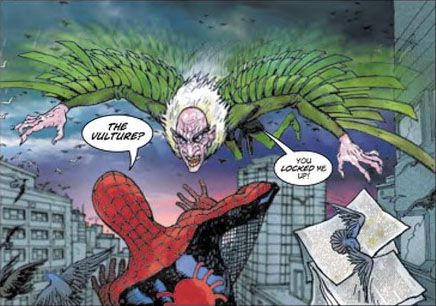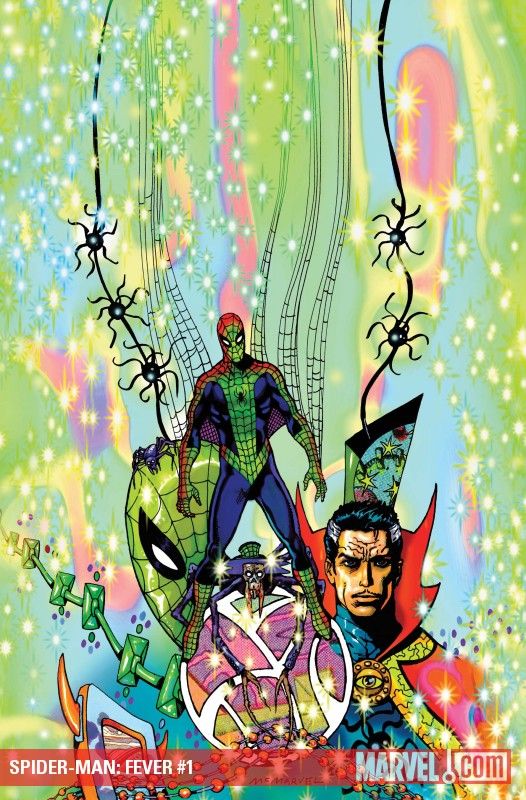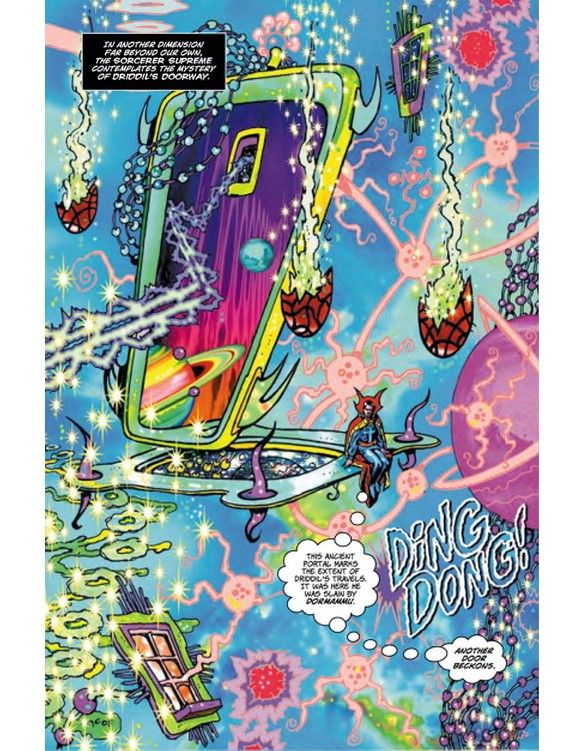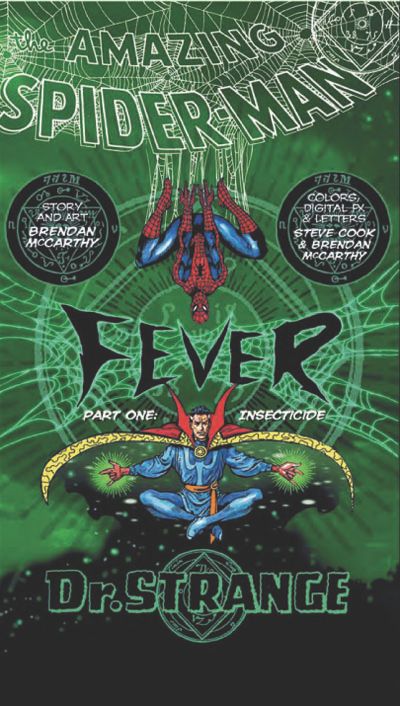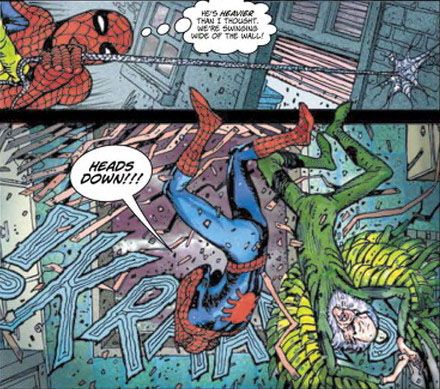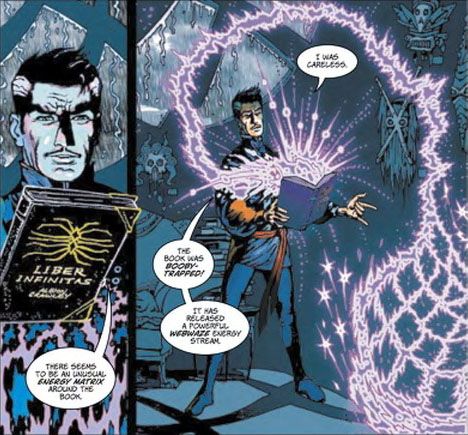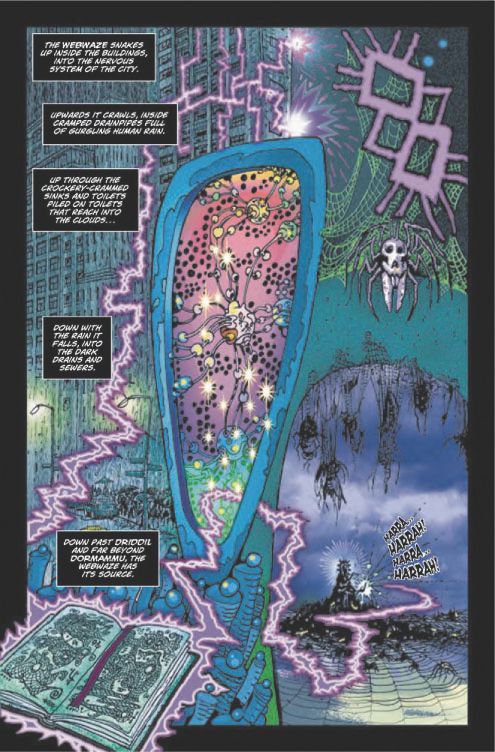One of the biggest problems with comics these days is that Brendan McCarthy simply isn't making enough of them.
The UK artist, known mainly for his inspired and frequently surreal collaborations with writer Peter Milligan during the 1980s and 90s, (most notably Skin and Rogan Gosh) hasn't produced any sequential art since his mind-bending issue of Solo (fittingly the last issue in that late, lamented series) six years ago, a comic which in itself marked a lengthy hiatus. In between those periods, McCarthy has opted instead to mostly work on various television and movie projects like Reboot, the Teenage Mutant Ninja Turtle movies and most recently a potential fourth Mad Max sequel.
Thankfully Marvel is about to change all that. The company that Disney bought has enlisted McCarthy to write and draw Spider-Man: Fever, a three-issue limited series starring the wall-crawler and Dr. Strange that will arrive in stores this April (or at least the first issue will).
I talked to McCarthy over email about the new series and the challenges it offered.
Q: Correct me if I'm wrong, but I think your last published comic was that final issue of Solo back in 2004. What have you been doing in the interim since then and what made you decide to return to comics after such a lengthy hiatus? More specifically, how did this particular project, FEVER, come about?
Steve Wacker asked me if I was interested in doing something for Marvel, after he had seen the DC Comics' SOLO material. I always thought I could do a decent take on Dr. Strange. He's my favorite Marvel character. One of my best-loved comic stories is the 1965 Silver Age Spider-Man and Dr. Strange annual story by Stan Lee and Steve Ditko. FEVER was inspired by that strip.
Q: Obviously it's not just coincidence that the two stars of Spider-Man: FEVER happen to be the two Marvel characters co-created by Steve Ditko. I know Ditko was a big influence on your work. Did you see this project as a chance to pay tribute to him? And if so, how did you go about doing so without it being too obvious or slavish a homage?
You're exactly right. Steve Ditko is a singular genius and I wanted to 'pay homage' but not be slavish... I'm obviously not in his artistic league, he really is a master, but I was happy to invent a story that utilized the amazing dimensional realities that he created all those years ago. Having done Shade and now Spider-Man and Dr. Strange -- all that I'd like to do next is The Creeper! (I have to admit, Hawk and Dove never really did it for me.)
I absolutely adore those pre-superhero short stories that Ditko did with Stan Lee. One day, I'm going to persuade Marvel to create a collection of the best of them and get them to print those classic stories on good quality paper with good inks. Those modern reprints in those garish colors are unbearable to me! Maybe best to scan off the original comic pages.
Q: Apart from Ditko, what were some of the other specific influences on Fever? I detect a bit of Lovecraftican horror in the mix for example.
No, not Lovecraft. I just can't get through his incredibly dense prose. The spooky story element is purely my own invention.
Other influences on this FEVER strip are Heinz Edelmann, the designer of the beautiful 'Yellow Submarine' film and some rather obscure Australian Aboriginal artists. There are some pages in the second issue where I was using aboriginal 'dot' designs with the lettering, to create swirling, psychedelic effects.
The UK designer Steve Cook contributed some very nice sfx and color throughout the strip as well. His own Alternity photographic work is very well done.
The occult artist Austin Osman Spare was looked at while I drew this, but more for the 'magickal atmosphere' of his thought.
Q: Apart from Ditko, what was it about Dr. Strange and Spider-Man that appealed to you? What is it about these two particular characters, that, say, Captain America or the Fantastic Four don't have?
My original pitch was for me to write and draw a Dr. Strange story, but Steve Wacker, as editor of the Spider-man line, said that if Spidey was in it, we would have a better chance of selling it to Marvel -- and it would help sales.
I'd quite like to do a good FF story sometime, as the Lee/Kirby run is still stunningly great. I did have a pitch called "The Fabulous Four" which was Stan Lee's original name for the group, an alternative 'take' on their origins. But let's see how this FEVER series goes down with the readers.
I think Mark Millar's version of Captain America, in the recent "Civil War" series, was right on the money. I have nothing to add to that character.
Q: I'm probably wrong about this, but apart from your Solo issue and Judge Dredd, you usually haven't worked on licensed or big pop culture characters (at least in comics at any rate). Were there any specific challenges in working with as familiar and beloved a character as Spider-Man that you didn't necessarily experience before? If so, how did you handle it?
I've always been interested in my own characters more than other people's. But for Dr. Strange I make an exception!
Otherwise, I feel I could do a really good "All Star" Flash for DC. I'd make it very 60s Infantino, using all that gallery of villains. Next to Batman, I'd say The Flash has got the best bunch of bad guys lined up against him.
The Creeper interested me too, for obvious Ditkovian reasons! Steve Niles had a decent stab at it but I don't think DC have nailed him properly yet.
I'd like to do a good Swamp Thing graphic novel too, as I really love the original -- and very bizarre -- Wein/Wrightson comic series.
Q: One of the things that struck me about the issues I read is the blend of humor and horror that runs through the series. One the one hand you've got these genuinely frightening spider monsters saying some very funny things. Is that blend of the serious and the silly important to you in your comics work? Do you worry at all about having one undercut the other?
No. Tonally, I like the comedic dialogue playing against the horror elements. Tarantino used opposing streams of comedy and extreme violence in Pulp Fiction to good effect. So it can work well if executed properly. There's definitely a 'Monty Python' type of surreal humor running through this story. But there's also some deeply emotional moments for the characters to live through as well. I like these things playing off each other.
Q: Can you talk a little bit about your working process on this comic at all? I notice for example, that you use a lot of vertical, as opposed to more traditional horizontal, panels in your layouts. What was the thinking behind that?
I am trying to get away from comics 'aping' movie storytelling. Comics are not films, so panels don't have to be shaped like movie screens. Comics do not move or have sound. They are really, a completely different medium. I know people want to get Hollywood to buy their stories, but I think it's now getting boring to merely copy movie storytelling tropes. Comics are comics, a totally different form! Time for comics to cut loose again.
Q: Am I correct in assuming that the sorcerer Crawley is a stand-in for Aleister Crowley?
Yes, you are correct. I have chosen to use Aleister in his tabloid-baiting "Wickedest Man in the World" persona. But unlike writers like Grant Morrison and Alan Moore, etc, I don't have that much regard for him. It all seems a bit silly when you're no longer a teenager. Crowley was a brilliant occultist and opportunist, but as a human being, he was a dismal failure. He was also quite mistaken in his final understanding of the nature of reality. He was never able to dis-identify with his ego and 'cross the Abyss'. I tend to prefer the other major British magician, Tommy Cooper.
Q: In some ways Fever has a much more straightforward or linear storyline than, say, your work in Solo or Rogan Gosh, despite the spiders and supernatural elements. Do you see this as being separate or different from your past comics projects because of that?
This is a Marvel Comic, so I think I should try something different, but keep it within mainstream sensibilities. I'd like it to appeal to as wide an audience as possible. And if it's a hit, well, I have a kind of sequel planned...
Q: A lot of times online I come across descriptions of your work as being "trippy" or "weird for weird's sake" which seems to me a bit shallow and dismissive. Does that sort of surface reading of your art bother you at all?
Not at all. My main pre-occupation in writing and drawing FEVER was to keep myself interested all through the process, as I get easily bored... So I make sure I'm surprising myself, moving in different directions with the art and writing. I like lots of ideas to be in a comic -- the ideas are what interest me the most really.
Hopefully the readers will be entertained by the book. Sometimes I make myself laugh when I'm creating the story. That's a good sign. It means that at least I had a good time!
Q: What's up with Swimini Purpose, your limited-edition art book? Any chance of a second printing coming out anytime soon? While I'm asking, any chance a new edition of Skin, Paradax! or Rogan Gosh will appear as well?
I'd like to do a completely new edition of SWIMINI PURPOSE at some point in the future. If a decent offer comes up, I'd certainly consider it. But it's probably best if I produce it myself as I get tired of people wasting my time.
As to all my other comics work, mainly created with Pete Milligan, well, I'm sure that one fine day a good quality 'collected ' edition will be available. We'll probably have to die first though. Currently, none of my past work is in print.
Q: What's happening with the new Mad Max movie, Fury Road? Are you still involved?
Over 8 years ago, I co-wrote and did core designs on Mad Max: Fury Road. That was quite a while ago, so I'm not sure how much of my script or design is still there. But I'm pleased to say that it's back in production. The director, George Miller is a very talented and savvy fellow and I look forward to seeing it. I just hope it's a good movie.

